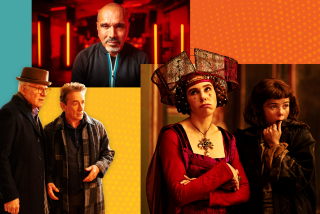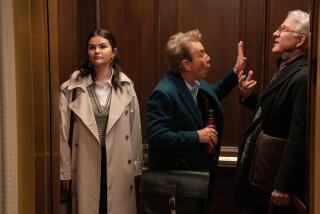Beware — serial killers loose on broadcast TV
In an alarming bit of synchronicity, or what some might call a lack of cultural imagination, two new series premiering on network television nearly within a month will revolve around serial killings, and serial killings by proxy: “Cult,” which begins Feb. 19 on the CW, and the similarly titled “The Following,” which starts Monday on Fox. BBC America’s period procedural “Ripper Street,” meanwhile, began its eight-episode run Saturday not with the Jack but a murderer — if such a comparative may be allowed — even more distasteful. And NBC has “Hannibal,” concerning the early days of Thomas Harris’ cannibal killer, on its docket for a date to be announced.
This is nothing new. We are in Season 8 of CBS’ “Criminal Minds,” a weekly cavalcade of just such intricately devised horrors whose viewership has hovered pretty consistently between 12 million and 14 million, with its ranking improving as the overall size of the broadcast audience has shrunk; it is a palpable hit. And there is “Dexter,” on Showtime, whose protagonist serially murders serial murderers.
At the recent Television Critics Assn. press conclave in Pasadena, where TV violence was a hot subject in the wake of the Newtown, Conn., school shooting, CBS Entertainment President Nina Tassler and NBC Entertainment Chairman Bob Greenblatt — a Showtime executive when “Dexter” was born — were called on to defend their series.
VIDEO: Upcoming winter TV trailer and dates
Each stood behind the product. Greenblatt defended “Dexter” by saying it isn’t as violent as “Criminal Minds.” Tassler defended “Criminal Minds” as something meant for adults, and a show she likes. (Former star Mandy Patinkin, by contrast, told New York magazine awhile back that the series was “the biggest public mistake I ever made.... I never thought they were going to kill and rape all these women every night, every day, week after week, year after year.”)
What is it about these characters that bothers me so?
They are supposed to bother us, of course, on the way to providing some sort of entertainment. (Perhaps it’s the “entertainment” that’s my problem.) Partly, it’s that in spite of all the pathologies and florid particulars with which their creators dress them and the complicated manners of killing they devise for them, they are tediously alike. Partly it is that, being deviant, they have nothing much to tell us about ourselves or the world — there may be more serial killers about than we think, but there are fewer than we imagine — and partly it’s the way that they are glamorized.
I understand that terror has its uses and am not averse to a bit of frightful catharsis; too much decorum in our shared fantasies can be as unhealthful as too little. Nor do I believe that, in a general way, violence in entertainment makes violent people; indeed, some studies have suggested quite the opposite. (A 2010 study from Texas A&M suggested, for instance, that “violent games reduce depression and hostile feelings in players through mood management.”)
But it does create violence in the culture, in the social air we commonly breathe, and objections to it should not be dismissed merely because it can’t be tied to a particular real-world act or because most of us are smart enough to tell the difference between fantasy and reality.
I recognize, as well, that great art has been made on this theme: “M,” “Monsieur Verdoux,” “The Night of the Hunter,” “Peeping Tom,” “Badlands” (a murder-spree story, technically), even that comedy chestnut “Arsenic and Old Lace.” There is violence in Homer and Shakespeare, and, Lord knows, there is violence in the Bible — both the fire and brimstone of the Old Testament and the feel-His-pain torments of the New. Dante was a great inventor of tortures. But we are talking about somewhat lower horizons here.
VIDEO: Upcoming winter TV trailer and dates
In most popular fictions, the serial killer is often not just smart but brilliant: almost psychically sensitive to their opponents and prey, able to play the game 10 moves ahead. These figures are self-styled übermenschen (they are usually menschen), typically with an “artistic” bent. “He didn’t just eviscerate 14 female students,” Kevin Bacon’s reactivated FBI agent says of James Purefoy’s Poe-obsessed serial killer (and leader of serial killers) in “The Following,” “he was making art.”
Created by Kevin Williamson (“Scream,” “Dawson’s Creek”), “The Following,” in which an imprisoned serial killer marshals an army of like-minded murderers, multiplying the effect, does seem to represent some sort of watershed for network TV. Its survival relies on the survival of its villain and, therefore, the continued failure of its hero, and an unending stream of variations on the central ritual — the stalking, the torture, the killing. (“Cult,” a kind of meta-series about a show-within-the-show called “Cult,” feels somewhat less gruesome for being more mysterious.) The success of “Criminal Minds” notwithstanding, and the many hands that had to sign contracts and checks to bring it to life, it strikes me as an odd, sad plan for a television show, at least in the framework of network broadcast TV.
As I never tire of pointing out, broadcast is not cable. It legally requires accountability, and not only to the stockholders and profit-takers of the large corporations that squat there and treat the frequencies they have been merely licensed to use as their actual property. When something airs there, it’s as if it were being projected in a public square, and it is weak to argue that you can just avoid that square if you don’t like it, when it is your square as much as anyone’s.
The oft-heard claim from broadcasters that they need to be able to compete with cable, where things can be darker and more explicit, is weak. Their profits are not the people’s concern; indeed, all the responsibility lies with the broadcasters, who are mandated to serve the public good, which is not exactly the same as giving the people what they want.
I don’t mean to suggest any kind of censorship, only a plea for the self-reflection that money tends to crowd out. And just as we should be able to discuss the gun problem without their makers and admirers digging in their feet like obstreperous children, we should be able to talk about violent entertainments without their makers and admirers suggesting that their 1st Amendment rights or the sanctity of their first-person-shooter video games, their Dario Argento and “Saw” DVDs, is under attack.
For the generations who grew up on Freddie and Jason and Leatherface and the slasher films from whose conventions Williamson fashioned “Scream,” and those who grew up on Quentin Tarantino’s hyperbolic remakes of an even earlier generation’s bloody fun, this may all seem a tempest in a teapot made from a human skull. There have been national panics before, after all, over this sort of thing — horror comics were once thought to signal the end of civilization, which was more or less functioning when last seen. We find amusingly quaint the terrors of olden days.
Every passing season sets a new level of tolerance for such things. Is raising that bar a worthwhile pursuit? Exactly what sort of glory attaches to being the person who topped “The Human Centipede”?
“Stop me before I kill again,” goes the familiar phrase. It isn’t likely, but it’s worth a thought.
More to Read
The complete guide to home viewing
Get Screen Gab for everything about the TV shows and streaming movies everyone’s talking about.
You may occasionally receive promotional content from the Los Angeles Times.







